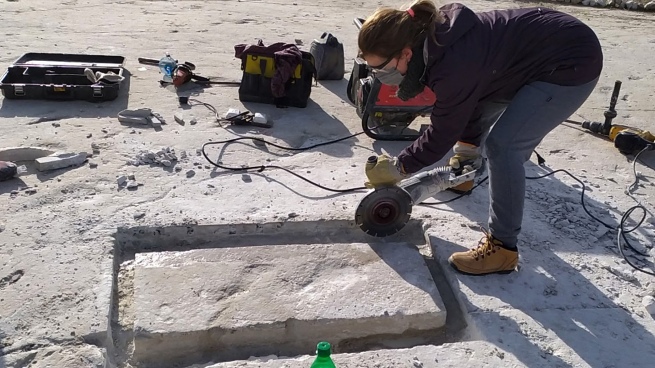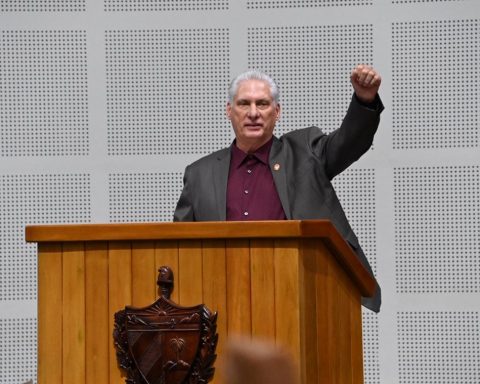The discovery of what could be fossil traces of shoals in a quarry in the town of Batán “makes the finding something unique worldwide,” said Matías Taglioretti, a researcher at the Municipal Museum of Natural Sciences of Mar del Plata, on Monday.
What scientists discovered and studied was the mold left by more than 120 fish with their bellies lying on the seabed during the lower Paleozoic era, on a surface that is part of the so-called Balcarce Formation, an outcrop of rock in the southeast of Buenos Aires.
The finding, published days ago through an article in the scientific publication Palaios, is the first documented evidence of fish tracks in the region, and it is also the oldest record in the world of this type of vertebrate swimming in a school.
a long investigation
The discovery was the result of a path of more than twelve years, which began in 2009, with a footprint that caught the attention of one of the scientists who participated in the work, in a stone defense built south of Mar del Plata. to stop coastal erosion.
As Matías Taglioretti, a researcher at the Municipal Museum of Natural Sciences of Mar del Plata, recalled, it was the trained eye of his colleague Fernando Scaglia who then noticed the first traces on a rock located on the coast of the El Marquesado areaon the side of route 11 that leads to Miramar.
“We were looking for something else, working in that area of cliffs, but Fernando showed me some traces on a stone block. They did not fit with anything known in the area. Those blocks come from the quarries in the Batán area, which keep part of what that was once the sea, so we started looking for where they came from,” Taglioretti told Télam.
Although they were unable to initially identify from which quarry those rocks had been extracted to build the defenses, almost seven years later they were able to do so, based on information provided by another researcher, Karen Halpern, from the National Council for Scientific and Technical Research (Conicet) and of the Quaternary Coastal Geology Institute (IGCyC), in turn dependent on the Buenos Aires Scientific Research Commission and the National University of Mar del Plata.
Halpern shared with Taglioretti and Scaglia a finding made by the IGCYC geologist Julio Luis del Río, who knew of those traces found on the coast years ago. and detected similar ones in a rocky surface of 5,000 square meters in a quarry located 20 kilometers west of Mar del Plata.
Since then, these traces were analyzed together, and more than five years later they could be crystallized in the recent scientific publication.

The traces were found on quartzite stone, known as “Mar del Plata stone”, and due to its hardness they had to use grinders with diamond discs and double vidia bits to drill them and take molds of the samples.
The work of analysis and study of the samples, and preparation of the report, also included the intervention of Soledad Gouiric-Cavalli, from the Museum of La Plata and Conicet, of Lydia Calvo Marcilese, from the Geosciences Area of YPF Tecnología SA
“The first find was out of context, that is, outside its original site. That meant there was a lot of information that we didn’t have between 2009 and 2017, until its rediscovery in the quarries. Now we had all the complete information of the geological context and a large number of traces that allowed us to see new and more things, “he assured.
Thus they were able to establish that the traces would belong to fish that they called Raederichnus Dondasi, which lived in the shallow seas and calm waters of the region, between 450 and 430 million years ago.
“We compared the footprints in size and shape with marine invertebrates and vertebrates that could exist at that time. Due to their size, about 35 centimeters, unsuitable for invertebrates known at the time, and due to their volume and certain drag marks typical of a sort of of tail, and also because there were no marks of legs and there were others that could correspond to fins, we infer that they were fish”, explained Taglioretti.
The conclusion they reached was that these fish could have had a batoid shape, like rays or mantas, but with a thicker tail, similar to that of the guitar fish.

Taglioretti added that another key point of the finding was that “these are footprints that had the same direction, they are group traces and they show a school behavior”.
“These fish swam together and rested on the seabed, as could be the case with the current sole,” he explained, noting in this sense that this data “makes the finding something unique both in Argentina and worldwide.”
After the publication in the bimonthly academic journal Palaios, dedicated to the study of the impact of life on Earth’s history, the researcher expressed his confidence that the discovery “renews interest in investigating this geological formation.”
“We compared the footprints in size and shape with marine invertebrates and vertebrates that could exist at that time. Due to their size, about 35 centimeters, unsuitable for invertebrates known at the time, and due to their volume and certain drag marks typical of a sort of of tail, and also because there were no leg marks and there were others that could correspond to fins, we infer that they were fish”, concluded Taglioretti.
















